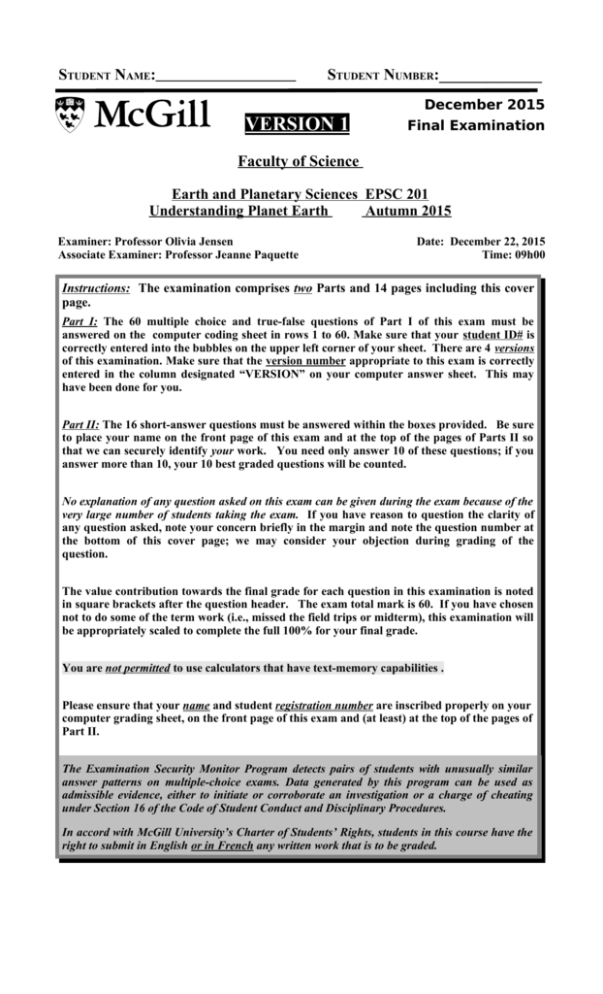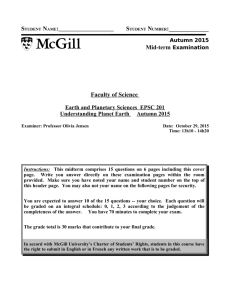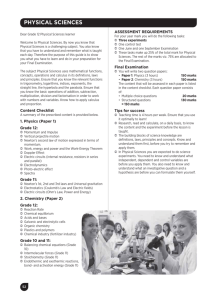VERSION 1 - Department of Earth and Planetary Sciences
advertisement

STUDENT NAME: STUDENT NUMBER:_____________ VERSION 1 December 2015 Final Examination Faculty of Science Earth and Planetary Sciences EPSC 201 Understanding Planet Earth Autumn 2015 Examiner: Professor Olivia Jensen Associate Examiner: Professor Jeanne Paquette Date: December 22, 2015 Time: 09h00 Instructions: The examination comprises two Parts and 14 pages including this cover page. Part I: The 60 multiple choice and true-false questions of Part I of this exam must be answered on the computer coding sheet in rows 1 to 60. Make sure that your student ID# is correctly entered into the bubbles on the upper left corner of your sheet. There are 4 versions of this examination. Make sure that the version number appropriate to this exam is correctly entered in the column designated “VERSION” on your computer answer sheet. This may have been done for you. Part II: The 16 short-answer questions must be answered within the boxes provided. Be sure to place your name on the front page of this exam and at the top of the pages of Parts II so that we can securely identify your work. You need only answer 10 of these questions; if you answer more than 10, your 10 best graded questions will be counted. No explanation of any question asked on this exam can be given during the exam because of the very large number of students taking the exam. If you have reason to question the clarity of any question asked, note your concern briefly in the margin and note the question number at the bottom of this cover page; we may consider your objection during grading of the question. The value contribution towards the final grade for each question in this examination is noted in square brackets after the question header. The exam total mark is 60. If you have chosen not to do some of the term work (i.e., missed the field trips or midterm), this examination will be appropriately scaled to complete the full 100% for your final grade. You are not permitted to use calculators that have text-memory capabilities . Please ensure that your name and student registration number are inscribed properly on your computer grading sheet, on the front page of this exam and (at least) at the top of the pages of Part II. The Examination Security Monitor Program detects pairs of students with unusually similar answer patterns on multiple-choice exams. Data generated by this program can be used as admissible evidence, either to initiate or corroborate an investigation or a charge of cheating under Section 16 of the Code of Student Conduct and Disciplinary Procedures. In accord with McGill University’s Charter of Students’ Rights, students in this course have the right to submit in English or in French any written work that is to be graded. Understanding Planet Earth EPSC 201 Autumn 2015 Student Name:___________________________ Final Examination Student Number:________________________ Part I This section comprises 60 multiple-choice questions. Each question is worth 1/2 mark. Indicate your answer by filling in the appropriate “○” open circle on the computer grading (Scantron) sheet. You should use pencil so that you can erase your reconsidered answers. Make sure that you have properly filled in your student ID# and the version number of this exam on the grading sheet. [30 marks] This is Version 1 1. What is our current best estimate of the age of the formation of Earth? A) B) C) D) E) 13.798 billion years 13.798 million years 4.567 billion years 4.567 million years 4004 BCE EPSC 201 Insert your name and student ID# on the top of the front page and pages of Part II. Version 1 Page 2 Understanding Planet Earth EPSC 201 Autumn 2015 Student Name:___________________________ Part II Final Examination Student Number:________________________ Short answer questions Please keep your response to each of the following eight questions within the space provided by the box. These questions are graded on a schedule of 0 marks (complete miss), 1 mark (addresses some of the question), 2 marks (well addresses the question), 3 marks (excellent and complete answer). You are only expected to do 10 of the following 16 questions. If you do more, your best 10 will count for grade. [ 30 marks ] 16. We now are beginning to recognize the Earth System comprising the physical and geological materials of the Earth and its place in the Solar System as well as the biology of planet, all working together producing a nearly stable environment and condition. In 1972, James Lovelock proposed the Gaia hypothesis which argued that life and biology is importantly involved in regulating the planet's surface environment. How does life contribute to the stability of the environment? EPSC 201 Insert your name and student ID# on the top of the front page and pages of Part II. Version 1 Page 3








